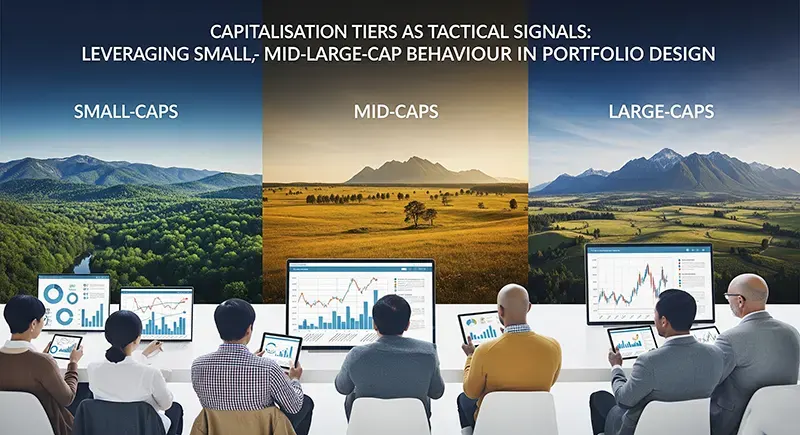Investing is no longer about simply choosing “good” companies—it’s about understanding how those companies fit within a broader, strategically built portfolio. One often underappreciated lens through which investors can optimise their asset allocation is market capitalisation. By recognising the distinct behaviour of small-, mid-, and large-cap stocks, traders and portfolio managers can uncover tactical signals that guide more responsive, risk-aware strategies.
Market capitalisation tiers do more than categorise companies by size—they reflect different growth trajectories, levels of volatility, sector biases, and investor sentiment.
Understanding the Capitalisation Spectrum
Before diving into tactical uses, it’s essential to grasp what defines each capitalisation tier. Broadly speaking:
- Small-cap stocks typically represent companies with a market value between $300 million and $2 billion. These firms often operate in emerging industries or niche markets.
- Mid-cap stocks fall between $2 billion and $10 billion in market capitalisation. They often occupy a transitional space—no longer startups but not yet global giants.
- Large-cap stocks are generally valued at $10 billion or more. These are the household names with established track records and consistent revenues.
Each tier carries unique attributes in terms of risk, return potential, and behaviour in different market cycles. You can explore a detailed breakdown of these segments through this content, which offers a solid foundation for understanding their roles in equity investing.
Tactical Signals: Reading the Market Through Size
One of the key advantages of viewing capitalisation tiers as tactical signals is their tendency to outperform or underperform based on macroeconomic conditions and investor appetite for risk.
Small-Caps: Early-Cycle Indicators
Small-cap stocks often act as early-cycle performers. When markets begin to recover from a downturn or recession, investors tend to rotate into small-caps, anticipating growth and seeking higher returns. Their agility allows them to respond quickly to economic green shoots, and their domestic focus—especially in regions like the UK or US—means they benefit directly from local economic recovery.
Tactically, a surge in small-cap performance can signal improving investor confidence and a broader risk-on sentiment. However, small-caps also come with higher volatility and sensitivity to interest rates and inflation. When tightening cycles begin or liquidity dries up, they’re typically the first to feel the strain.
Mid-Caps: Balance and Momentum
Mid-cap stocks can serve as a stabilising tactical anchor. They combine growth potential with more maturity and operational stability than small-caps. In portfolio design, mid-caps are often leveraged during the middle of the economic cycle, when growth is neither overheating nor stalling.
Their behaviour can also offer valuable clues. If mid-caps are outperforming both small- and large-caps, it may indicate broad economic strength without speculative excess. Conversely, a sell-off in mid-caps could suggest waning confidence in the near-term growth outlook, even if large-cap defensives are holding up.
Large-Caps: Late-Cycle Resilience
Large-cap stocks, particularly those in defensive sectors like healthcare, utilities, and consumer staples, often dominate during late-cycle or recessionary periods. Their size, access to capital, global exposure, and institutional investor interest provide a buffer against downturns.
From a tactical standpoint, a shift toward large-cap outperformance may signal rising caution in the market. When investors prioritise capital preservation and dividend stability over aggressive growth, large-caps become the natural safe haven. In portfolio design, overweighting large-caps during times of uncertainty can serve as a hedge without moving entirely to cash or fixed income.
Portfolio Design Implications
Recognising these behavioural patterns allows traders and asset managers to adjust their positioning proactively rather than reactively. Here are several ways to incorporate capitalisation signals into a dynamic portfolio strategy:
Tilt Allocation Based on Market Cycle
Rather than locking in a static percentage for each capitalisation tier, consider a dynamic tilt approach. For example:
- Recovery phase: Tilt toward small- and mid-caps, anticipating outsized growth.
- Expansion phase: Maintain balance with a core in mid-caps while selectively rotating into large-caps with cyclical exposure.
- Late-cycle or recession: Shift weight toward large-cap defensive stocks to preserve capital.
This cyclical framework aligns capitalisation exposure with broader economic signals, enhancing both agility and resilience.
Diversify by Volatility Profile
Capitalisation tiers come with varying risk levels. Combining them in a portfolio helps smooth volatility. Small-caps may spike or plummet based on sentiment, while large-caps tend to move more gradually. Mid-caps often strike a middle ground. Blending these behaviours can provide a more consistent return profile without sacrificing growth potential.
Use Relative Performance as a Signal
Watch for changes in relative strength among the tiers. Tools like moving averages or ratio charts (e.g., small-cap index vs. large-cap index) can offer insights into momentum shifts. If small-caps begin to outperform large-caps after a prolonged downturn, it could mark the start of a bullish phase—and vice versa.
Empowering Portfolio Evolution
Using capitalisation tiers as tactical signals offers more than just the potential for higher returns — it brings structure, intent, and adaptability to your investment strategy. By viewing small-, mid-, and large-caps as behavioural indicators, investors gain a sharper lens for interpreting market shifts and adjusting accordingly.
Whether building a long-term diversified portfolio or engaging in active allocation, this approach supports smarter, more responsive decisions. Paired with macro insights and sector analysis, it evolves basic asset allocation into a strategy that speaks the market’s language — one where size, momentum, and stability each play a vital role.










